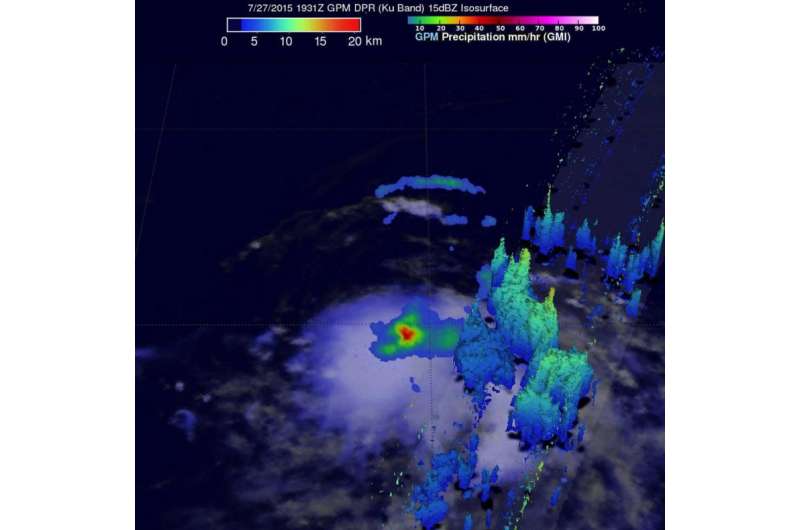NASA's GPM satellite sees heavy rainfall in new Tropical Depression 8E

The eighth tropical depression of the Eastern Pacific Ocean hurricane season formed far from land as the Global Precipitation Measurement (GPM) core satellite passed overhead and measured rainfall and cloud heights.
The GPM core observatory satellite is co-managed by both NASA and the Japan Aerospace Exploration Agency. GPM flew over Tropical Depression 08E (TD08E) when it was forming on July 27, 2015 at 1931 UTC (3:31 p.m. PDT). GPM's Microwave Imager (GMI) and Dual-Frequency Precipitation Radar (DPR) measured rain falling at a rate of 50 mm (almost 2 inches) per hour in storms near the center of tropical depression.
GPM's DPR instrument scan viewed an area east of the center of the developing tropical depression. A simulated 3-D view of storm tops measured by Ku Band radar had reached heights above 14.2 km (8.8 miles). By 5 p.m. EDT, the National Hurricane Center announced that Tropical Depression 8E formed near 15.6 North latitude and 126.1 West longitude.
Twelve hours later at 5 a.m. EDT (0900 UTC) on July 28, the center of Tropical Depression Eight-E was located near latitude 16.2 North, longitude 128.0 West. That puts the center about 1,265 miles (2,035 km) west-southwest of the southern tip of Baja California, Mexico.
The depression was moving toward the west-northwest near 13 mph and is expected to turn west later in the day. Maximum sustained winds were near 35 mph (55 kph) and the depression could become a tropical storm later in the day. The estimated minimum central pressure is 1007 millibars.
National Hurricane Center (NHC) forecaster Cangialosi noted that "The depression is currently experiencing about 15 knots (15.8 mph/27.7 kph) of north-northwesterly shear, which is the reason why most of the thunderstorms are located to the south of the center."
By July 30, TD08E is expected to move into a more stable air mass and over slightly cooler water, which will prevent the storm from further development.
Provided by NASA's Goddard Space Flight Center





















